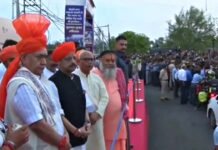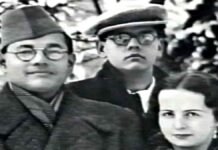
As India commemorates the 79th death anniversary of Netaji Subhash Chandra Bose on August 18, 2024, the nation remembers his indomitable spirit and relentless fight for freedom. While his tales of patriotism are widely known, few are aware of the deep and poignant love story that unfolded alongside his battle for India’s independence. On this solemn day, we delve into the lesser-known chapter of Netaji’s life a chapter that reveals a love as enduring as his revolutionary fervor.
A Revolutionary’s Journey to Love: Meeting Emily Schenkel
The year was 1932, a time when Subhash Chandra Bose, a key figure in India’s Civil Disobedience Movement, found himself imprisoned by the British. His health deteriorated rapidly in February of that year, prompting the British government to allow him to seek medical treatment in Europe. Bose’s journey took him to Vienna, Austria, where he would embark on a mission to unite Indian students in Europe for the freedom struggle. However, this journey also led him to encounter a love that would forever change his life.
In June 1934, while working on a book titled “The Indian Struggle” at the request of a European publisher, Bose met Emily Schenkel, a young, open-minded German woman. Emily was hired to type his manuscript, and it was through this professional collaboration that a deep bond began to form between the two. Though their initial interaction was brief, it planted the seeds of a love that would transcend continents and political upheaval.
The Blossoming of Love: A Long-Distance Romance
Later that year, Bose was forced to return to India after receiving news of his father’s illness. Unfortunately, he arrived too late—his father had already passed away. It was only after his return to India, while under house arrest at his brother’s home in Darjeeling, that Bose realized the depth of his feelings for Emily. Separated by thousands of miles, the two began exchanging letters, and it was through this correspondence that their love story truly blossomed.
In a time before instant communication, these letters became the lifeline of their relationship, filled with emotion and longing. As Bose continued to fight for India’s independence, his thoughts often drifted to Emily, the woman who had quietly captured his heart.
A Secret Marriage and a New Beginning
In 1936, Bose returned to Europe under the guise of seeking medical treatment and was reunited with Emily in Germany. The two spent significant time together between 1937 and 1938, and it is during this period that they are believed to have secretly married. Emily, ever supportive of Bose’s cause, never demanded promises of togetherness or assurances of a conventional life. She understood that his heart was split between his love for her and his unwavering dedication to India’s freedom.
Their time together was short-lived, as Bose returned to India in January 1939, ready to plunge back into the freedom struggle. But even as he faced the immense challenges of leading a revolutionary movement, his thoughts remained with Emily, the woman who had become his partner in spirit, if not in daily life.
A Daughter Born Amidst War and Revolution
During a brief period between 1941 and 1943, Bose and Emily reunited in Italy, where they spent precious moments together. It was during this time that their daughter, Anita Bose Pfaff, was born in 1942. However, Bose’s commitment to India once again took precedence, and in 1943, he departed for Southeast Asia to continue his struggle. Tragically, this would be the last time Emily would see him. Bose’s untimely death was reported on August 18, 1945, leaving Emily to raise their daughter alone.

The Enduring Legacy of Love
Subhash Chandra Bose never openly spoke of his marriage to Emily, keeping their relationship private even as he led public battles. It was only after his death that the world learned of his love letters, preserved in the book “Emily and Subhash,” written by his nephew’s wife, Krishna Bose. In one such letter, dated March 5, 1936, Bose poignantly wrote, “I do not know what will happen in the future. I may have to spend my entire life in jail, I may be shot or hanged. I may never see you, I may never write to you – but believe me, you will always be in my heart, in my thoughts, and in my dreams.”
After Bose’s death, Emily courageously raised their daughter Anita alone in Germany. Anita grew up hearing stories of her father’s homeland, a place she would come to associate with both pride and loss. Emily passed away in 1996, but her love for Bose remained unshaken, as did the memories of their brief but intense time together.
Today, as India remembers the sacrifices of Netaji Subhash Chandra Bose, his love story with Emily Schenkel stands as a testament to the complexity of his life a life filled with both heroic deeds and profound personal connections. Just as Netaji’s legacy lives on in the annals of history, so too does the love he shared with Emily, a love that continues to inspire and move hearts across the world.












































